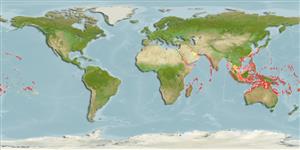>
Acanthuriformes (Surgeonfishes) >
Acanthuridae (Surgeonfishes, tangs, unicornfishes) > Acanthurinae
Etymology: Zebrasoma: Derived from Zebra = African horse + Greek, soma = body; referring to the stripes (Ref. 45335).
More on author: Bloch.
Environment: milieu / climate zone / depth range / distribution range
Écologie
marin récifal; profondeur 0 - 45 m (Ref. 90102), usually 2 - 30 m (Ref. 27115). Tropical; 24°C - 28°C (Ref. 27115); 36°N - 25°S, 33°E - 134°W
Eastern Indian Ocean to the Pacific Ocean: Christmas Island and most of the East Indian region to South China Sea, Hawaii and Pitcairn Islands; north to Japan and Ogasawara Islands; south to western and eastern Australia; Replaced by Zebrasoma desjardinii in the Indian Ocean.
Taille / Poids / Âge
Maturity: Lm ? range ? - ? cm
Max length : 40.0 cm SL mâle / non sexé; (Ref. 9710)
Épines dorsales (Total): 4 - 5; Rayons mous dorsaux (Total): 29-33; Épines anales 3; Rayons mous anaux: 23 - 26. Smalls juveniles have alternating yellow and black bars. No brush-like patch of setae posteriorly on side of body. Dorsal fin very elevated, the longest ray 2.1 to 2.5 times in SL (Ref 9808).
Benthopelagic (Ref. 58302). Occurs in lagoon and seaward reefs from the lower surge zone to a depth of at least 30 m. Solitary juveniles found among rocks or coral (Ref. 58534) of shallow protected, sometimes turbid reefs (Ref. 1602, 48637). Feeds on leafy macroalgae. It possesses, fewer and larger pharyngeal teeth, compared to the other Zebrasoma spp. (Ref. 33204). Diurnal species (Ref. 113699:32); courtship and spawning takes place from morning to afternoon and is often confined to ebb tides (Ref. 38697). The species is never poisonous (Ref. 4795). Minimum depth reported taken from Ref. 128797.
Life cycle and mating behavior
Maturité | Reproduction | Frai | Œufs | Fécondité | Larves
Paired spawning (Ref. 240).
Myers, R.F., 1999. Micronesian reef fishes: a comprehensive guide to the coral reef fishes of Micronesia, 3rd revised and expanded edition. Coral Graphics, Barrigada, Guam. 330 p. (Ref. 37816)
Statut dans la liste rouge de l'IUCN (Ref. 130435)
Menace pour l'homme
Harmless
Utilisations par l'homme
Pêcheries: intérêt commercial mineur; Aquarium: Commercial
Plus d'informations
RéférencesAquacultureProfil d'aquacultureSouchesGénétiqueElectrophoresesHéritabilitéPathologiesTraitementNutrientsMass conversion
Outils
Articles particuliers
Télécharger en XML
Sources Internet
Estimates based on models
Preferred temperature (Ref.
123201): 24.8 - 28.9, mean 27.6 °C (based on 874 cells).
Phylogenetic diversity index (Ref.
82804): PD
50 = 0.5078 [Uniqueness, from 0.5 = low to 2.0 = high].
Bayesian length-weight: a=0.02399 (0.01460 - 0.03941), b=2.93 (2.79 - 3.07), in cm total length, based on LWR estimates for this species & (Sub)family-body (Ref.
93245).
Niveau trophique (Ref.
69278): 2.0 ±0.00 se; based on food items.
Generation time: 3.9 ( na - na) years. Estimated as median ln(3)/K based on 1
growth studies.
Résilience (Ref.
120179): Milieu, temps minimum de doublement de population : 1,4 à 4,4 années (K=0.282; Tmax=27).
Fishing Vulnerability (Ref.
59153): Moderate vulnerability (37 of 100).
Nutrients (Ref.
124155): Calcium = 30.7 [14.1, 91.0] mg/100g; Iron = 0.723 [0.256, 1.679] mg/100g; Protein = 18.1 [16.8, 19.4] %; Omega3 = 0.131 [0.063, 0.270] g/100g; Selenium = 14.2 [5.0, 55.8] μg/100g; VitaminA = 42.1 [9.4, 172.9] μg/100g; Zinc = 1.83 [0.83, 3.21] mg/100g (wet weight);
